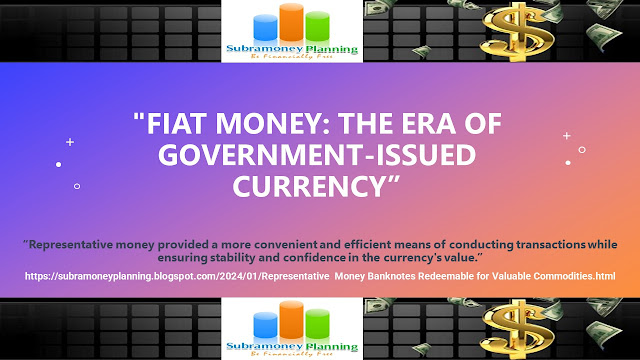Fiat money represents a significant shift in the evolution of currency. It refers to a form of money that has value solely because a government declares it as legal tender. Unlike commodity-based or representative money, fiat money is not backed by a physical asset, such as gold or silver. In this blog post, we will explore the time span and context of fiat money, provide an example of how it is implemented, discuss its features, and examine the pros and cons associated with this form of currency.
 |
Time span and context: The widespread adoption of fiat money began in the 20th century, with various countries transitioning from commodity-based or representative currencies to fiat currencies. This shift was primarily driven by economic and political factors, as governments sought to gain greater control over their monetary systems and foster stability in their economies.
Example: Officially declared legal tender by governments: An example of fiat money is the currency issued by governments, such as the United States dollar (USD), the Euro (EUR), or the Japanese Yen (JPY). These currencies are officially declared legal tender by their respective governments, meaning they must be accepted as a form of payment within the country.
Features of fiat money:
1. Government-backed: Fiat money is backed by the full faith and credit of the government that issues it. This backing instills confidence and trust in the currency's value and ensures its acceptance within the economy.
2. Legal tender: Fiat money is legally recognized as a valid form of payment for all debts, public and private. This designation obliges individuals and businesses to accept the currency as a means of settling financial obligations.
3. No intrinsic value: Unlike commodity-based money, fiat money does not have intrinsic value in and of itself. Its value is derived solely from the trust and confidence placed in it by individuals and the stability of the issuing government.
4. Centralized control: Fiat money allows central banks or monetary authorities to exercise control over the money supply, interest rates, and other monetary policies. This control enables governments to manage economic stability and respond to changing economic conditions.
Pros and cons of fiat money:
Pros:
1. Flexibility and Adaptability: Fiat money offers greater flexibility compared to commodity-based or representative money. Governments can adjust the money supply and implement monetary policies to address economic challenges and promote stability.
2. Stability and Confidence: Fiat money, when managed effectively, can provide stability and confidence in the currency's value. Governments can take measures to stabilize the economy, manage inflation, and ensure the smooth functioning of financial systems.
3. Convenience and Universality: Fiat money is widely accepted within a specific country or region, making it convenient for day-to-day transactions. Its universal acceptance fosters economic activities, trade, and commerce.
Cons:
1. Risk of Inflation: One of the significant concerns associated with fiat money is the risk of inflation. When governments have the power to create money at will, there is a potential for excessive money supply, leading to a decrease in the currency's purchasing power and an increase in prices.
2. Dependency on Government Stability: The value and stability of fiat money rely heavily on the stability and credibility of the issuing government. Economic or political instability can undermine confidence in the currency and lead to a loss of value.
3. Vulnerability to Manipulation: Fiat money can be susceptible to manipulation by governments or central banks. Mismanagement or improper monetary policies can have adverse effects on the economy, leading to economic crises and instability.
4. Lack of Intrinsic Value: Fiat money lacks intrinsic value and is solely based on trust and confidence. In times of economic uncertainty or loss of trust, individuals may seek alternative forms of value storage, such as commodities or cryptocurrencies.
Example: The United States Dollar (USD)
For:
1. Flexibility and Adaptability: Fiat money, like the United States Dollar (USD), offers flexibility and adaptability in monetary policy. The central bank, the Federal Reserve, can adjust the money supply, interest rates, and other monetary tools to respond to economic conditions, promoting stability and growth.
2. Stability and Confidence: Fiat money provides stability and confidence when managed effectively. Governments can take measures to control inflation, ensure the smooth functioning of financial systems, and instill trust in the currency, bolstering economic activity and investor confidence.
3. Convenience and Universality: Fiat money, particularly widely accepted currencies like the USD, offers convenience and universality. It is accepted as a medium of exchange in various transactions, facilitating trade, commerce, and international business.
Against:
1. Risk of Inflation: One of the main concerns associated with fiat money is the risk of inflation. Governments have the power to create money, and if done excessively, it can lead to a decrease in the currency's purchasing power, eroding the value of savings and causing economic instability.
2. Dependency on Government Stability: The value and stability of fiat money rely heavily on the stability and credibility of the issuing government. Economic or political instability, corruption, or mismanagement can undermine confidence in the currency and lead to its devaluation or loss of trust.
3. Vulnerability to Manipulation: Fiat money can be susceptible to manipulation by governments or central banks. Unsound monetary policies, such as excessive money printing or artificially low interest rates, can distort asset prices, create economic imbalances, and contribute to financial crises.
4. Lack of Intrinsic Value: Fiat money lacks intrinsic value and is based on trust and confidence. It is not backed by a physical commodity, such as gold, which can lead to concerns about its long-term stability and the potential for loss of value.
5. Alternative Forms of Value Storage: Fiat money's reliance on trust and confidence may drive individuals to seek alternative forms of value storage, such as commodities like gold, cryptocurrencies like Bitcoin, or stable coins backed by assets, as they may offer perceived stability and security.
Fiat money represents a significant shift in the evolution of currency, relying on government declaration and acceptance as legal tender. While fiat money offers flexibility, stability, and convenience, it also carries risks such as inflation, dependency on government stability, vulnerability to manipulation, and the lack of intrinsic value. Understanding the features and pros and cons of fiat money provides valuable insights into the modern monetary system and the challenges faced in maintaining stability and trust in currency value.







